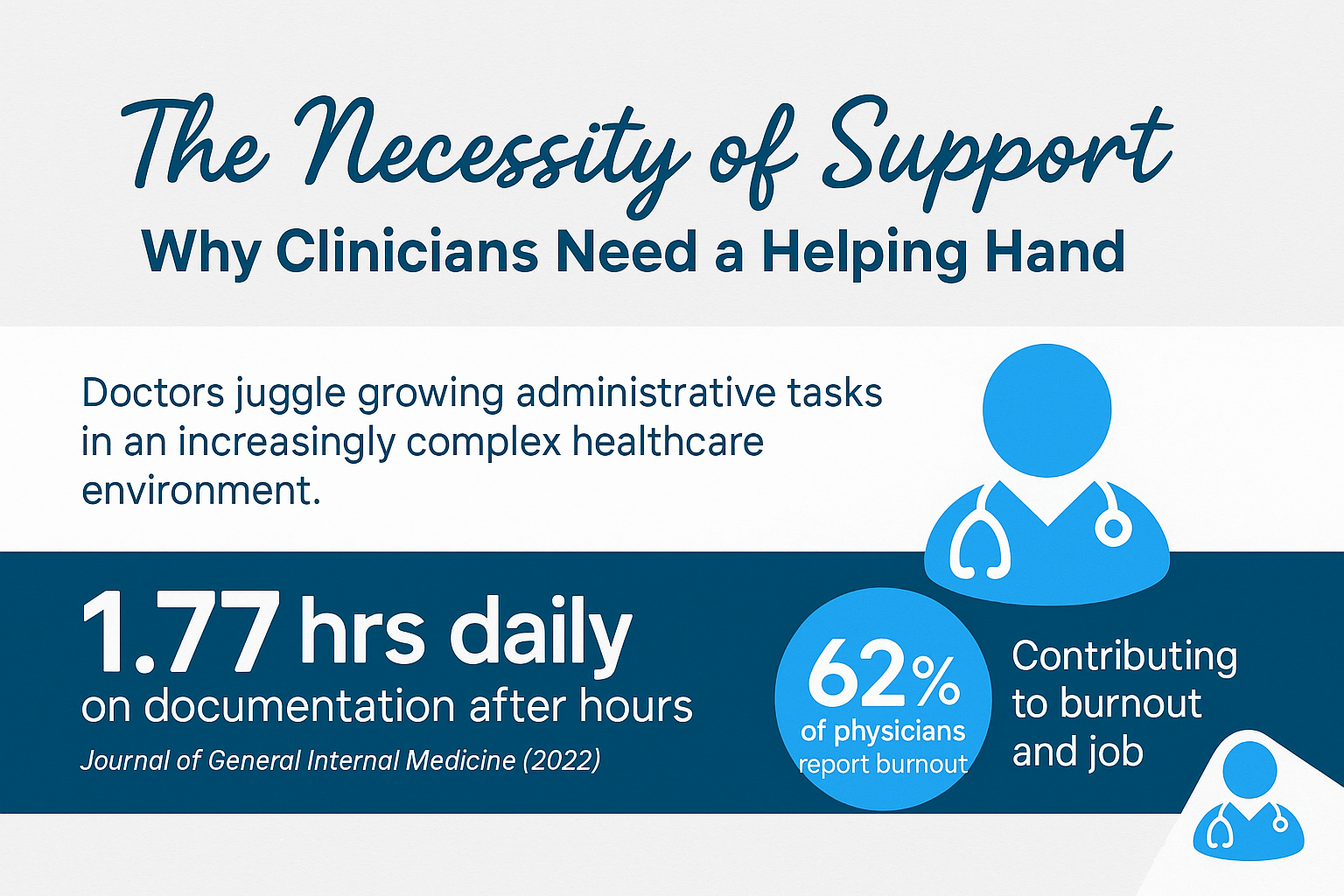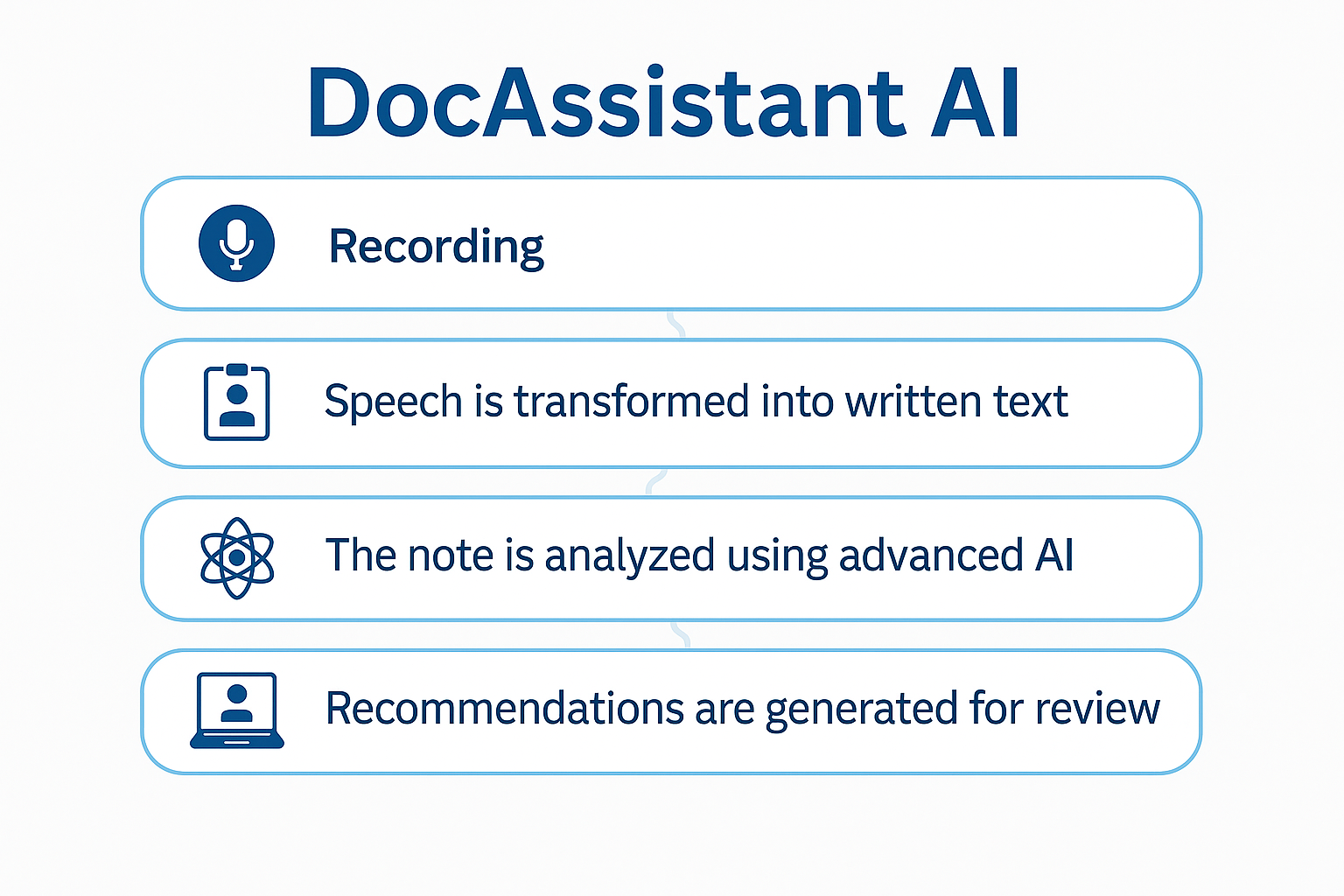Why DocAssistant AI Is More Than a Scribe

The US healthcare system has experienced massive changes in the past few years. With the increasing influx of patients, doctors are overburdened, not with patient care, but with the additional administrative tasks they need to do. Documentation tasks take up valuable time of medical professionals, resulting in burnout and reducing the quality of patient care.
A 2023 report suggested that 45.2% of physicians experience at least one symptom of burnout, a notable decrease from 62.8% in 2021, yet alarmingly high. A major reason for this burnout is that maintaining electronic health records (EHRs) can be time-intensive. Physicians spend nearly six hours on EHRs for every eight hours of patient-scheduled time, with documentation accounting for approximately 24% of this duration.
Enter medical scribes - designed to reduce the burden of healthcare physicians and streamline their workflow. Studies indicate that scribes can enhance physician satisfaction, improve chart quality, and increase efficiency. However, traditional scribes provide limited functionality and are limited by human variability and scalability challenges.
This is where AI-powered solutions like DocAssistant come into play. Real-time clinical guidance, differential diagnosis suggestions, and evidence-based recommendations - all integrated into a single software - DocAssistant is designed to support clinicians in making informed decisions swiftly. Such capabilities are especially beneficial in high-pressure environments where timely decisions are critical.
In this blog, we will explore what makes Doc Assistant more than an AI scribe, and how it offers a comprehensive solution that not only streamlines documentation but also enhances clinical judgement and patient care.
The Rise of Medical Scribes in the US
Owing to the increasing administrative burdens faced by healthcare providers in the US, the adoption of medical scribes has surged. As EHRs became prevalent, physicians were found to dedicate more time to administrative tasks like documentation, often at the expense of direct patient care. To help doctors free their time, many have turned to medical scribes. These are dedicated professionals who assist in real-time documentation during patient encounters.
A study published in JAMA Internal Medicine highlighted that the use of medical scribes led to significant improvements in physician satisfaction, chart quality, and charting efficiency, without compromising patient satisfaction. Another study in an academic general internal medicine setting found that employing scribes was associated with improved physician satisfaction, emphasizing the positive impact scribes have on clinician well-being.
The American Medical Association (AMA) also recognizes the benefits of medical scribes. According to the AMA, the use of scribes results in lower physician documentation burden and improved efficiency, workflow, and patient-physician interaction.
While traditional scribes have alleviated some of the documentation challenges, the integration of artificial intelligence (AI) into scribing presents an opportunity to further enhance efficiency and accuracy. AI-powered solutions, such as our own, aim to build upon the foundation laid by human scribes, offering real-time clinical guidance, differential diagnosis suggestions, and evidence-based recommendations. These advancements not only streamline documentation but also support clinicians in making informed decisions swiftly, marking a significant evolution in the role of medical scribes.
The Necessity of Support: Why Clinicians Need a Helping Hand

In today’s increasingly complex healthcare environment, clinicians are expected to balance medical expertise with a growing list of administrative responsibilities. Between patient interactions, documentation, billing codes, compliance requirements, and staying current with medical research, the cognitive load placed on healthcare providers is immense. According to a 2022 study published in the Journal of the American Medical Association, physicians spend nearly 1.77 hours after clinic hours completing documentation daily, contributing significantly to burnout and job dissatisfaction.
This overload has serious implications: physician burnout not only affects providers’ well-being but also leads to increased medical errors and reduced quality of patient care. Clinicians, especially in high-volume specialties like Emergency Medicine, often face decision fatigue—where the sheer volume of decisions made daily can reduce cognitive performance. In this context, the need for supportive tools becomes clear.
AI-powered platforms like Doc Assistant serve as an essential helping hand. These tools don’t replace clinical judgment but rather enhance it by offering real-time suggestions, organizing data efficiently, bringing relevant trusted medical sources to the provider and minimizing the need to toggle between systems. By alleviating the administrative burden and reinforcing evidence-based decision-making, AI CDS tools like DocAssistant empower clinicians to focus more fully on patient care.
DocAssistant: A Closer Look at Its Functionality
DocAssistant is more than just an AI-powered medical scribe - it’s a comprehensive clinical assistant designed to transform the way providers work. Built to go beyond note-taking, it seamlessly supports the entire clinical documentation and decision-making process from start to finish.
The workflow begins with data capture. DocAssistant can either listen passively during patient interactions, accept clinician dictation, or integrate with manual data entry. Unlike traditional dictation tools, it doesn’t just transcribe - it actively understands the clinical context. Once data is captured, our proprietary AI engine processes the information in real time, identifying possible causes and treatments based on current medical guidelines and literature.
Within seconds, DocAssistant generates a complete and structured note tailored to the provider’s preferences. Whether using SOAP, H&P, or MDM formats, the notes are clean, contextually accurate, and ready for review. Importantly, providers remain in control- they can edit, approve, or personalize the content before finalizing.
Beyond documentation, DocAssistant also provides real-time clinical suggestions, such as differential diagnoses, potential lab tests, and treatment options. This embedded intelligence augments clinical decision-making, especially in complex or time-sensitive cases.
Integration is designed to be frictionless. DocAssistant works alongside existing workflows and EHRs, ensuring minimal disruption and maximum efficiency. It’s also HIPAA-compliant, with enterprise-grade security standards in place to protect patient data.
In essence, DocAssistant functions as a smart co-pilot- handling the burden of documentation while amplifying the provider’s cognitive capacity. This enables clinicians to spend less time at the screen and more time delivering high-quality patient care.

Key Features of DocAssistant
DocAssistant stands out in the crowded field of medical AI tools due to its robust, user-focused feature set that goes far beyond basic transcription. At its core, it’s designed to be a real-time clinical documentation and decision support system that adapts to the needs of busy healthcare providers.
One of its most powerful features is automated, intelligent note generation. DocAssistant can create highly accurate clinical notes from ambient listening, clinician dictation, or manual input. These notes are fully customizable to match each provider’s style and workflow.
Another standout capability is real-time clinical guidance. As the conversation unfolds, DocAssistant can suggest differential diagnoses and offer evidence-based treatment recommendations. This feature serves as a cognitive augmentation tool- empowering clinicians to make better-informed decisions, faster.
At DocAssistant, security and compliance are top priorities. DocAssistant is HIPAA-compliant and uses end-to-end encryption to safeguard sensitive patient data.
Finally, customizability makes it adaptable across specialties, from Emergency Medicine to Primary Care, each feature is engineered to reduce documentation time, enhance clinical judgment, and improve the overall provider experience, allowing clinicians to get back to what matters most: patient care.
Benefits of Using Doc Assistant
DocAssistant comes with a comprehensive suite of benefits that aims to ease the challenges physicians face today. Today, physicians are burdened with documentation overload, decision fatigue and time constraints. DocAssistant was designed to mitigate these issues.
Time Savings
One primary advantage of using DocAssistant is time savings. By automating documentation and streamlining workflows, DocAssistant reduces the average time spent on documentation by hours every week. However, it isn’t just about working faster- but also about working smarter and using the reclaimed time on things like patient care and maintaining a work-life balance.
Better Clinical Judgement
DocAssistant comes with access to the latest medical knowledge and other best practices. This allows it to dish out better and more confident decisions. In other words, whether it needs to suggest treatment options or flag potential issues, it functions like a second brain in the background. So, while clinicians focus on patients, DocAssistant silently works in the background and makes sure that clinical recommendations are backed by relevant insights in real time.
Improved Patient Engagement
What do you think happens when documentation becomes a seamless process? Well, healthcare professionals get more time with the patient. With our tool handling all the documentation and other backend activities, clinicians can give a more patient listening to people. Needless to say that this improves patient satisfaction, deepens their patient trust, and allows doctors to focus on the patient clinician relationship.
Consistency in Documentation
Human note-taking will vary depending on amount of energy and the clinician behind the keyboard. DocAssistant standardizes the patient note and with a poignant emphasis on medical-legal writing and optimizing reimbursement, DocAssistant gives ERs, medical clinics and hospitals the ability to not lose out on potential revenue and protect themselves legally.
Challenges and Trends in AI Integration in Healthcare
Modern AI is making notable waves in the healthcare sector- be it in predicting diagnoses or simply streamlining documentation. However, much like any new technological innovation, it comes with its own challenges.
Data Privacy
Let’s face it, patient data is sensitive and with AI tools parsing vast amounts of data every single day, the stakes are very high. In fact, as per a data shared by IBM on the associated cost of a data breach, the healthcare sector has the highest data breach costs - averaging around $10.93 million each breach. Thats why at DocAssistant we maintain well above industry standard security protocols.
Bias in Algorithms
As the saying goes, AI is only as good as the data on which it is trained. So, if the data is skewed or lacks diversity, the end result will be flawed as well. In fact, back in 2020, a study by The New England Journal of Medicine revealed that some artificial intelligence algorithms underestimated the health needs of Black patients, mostly because of biased training data. Current tools must build guardrails to prevent the AI propagations of these inequities.
Regulatory Compliance
Modern AI tools in the healthcare sector must meet strict regulatory practices/guidelines, such as the likes of HIPAA and FDA, SOC2 or other such certifications - all of which somewhat thwart or at least slow down the rate of progress. Thus, developers must meet/adapt modern healthcare standards to ensure clinical safety.
That said, despite all these challenges, use of AI in the healthcare industry is on the rise and rightly so. By some estimates the market is set to expand to $187 billion by 2030, and for good reason. AI will enable clinicians to faster, more accurate diagnoses, better patient outcomes, and improved workflows.
Key Takeaway
Healthcare isn’t getting any simpler and with rising patient loads and administrative demands, things like clinical burnout are getting more common. Luckily, we now have access to smart, supportive solutions that aren’t just nice to have but also absolutely essential by today’s standards. This is what makes using DocAssistant a no-brainer. It is a tool that lightens the administrative and cognitive load.
Tools like DocAssistant are the way of the future in medicine. As AI continues to mature over the next few years, so will DocAssistant. You should expect continually deeper EHR integration, better personalized recommendations and decision support, and greater interoperability across legacy and modern systems. With continuous upgrades and improvements, the challenges we meet today are likely to become a story of the distant past.
So, in a world where time is scarce and quality is of the utmost importance, DocAssistant comes across as a bridge between humans and the technological advancements in the healthcare industry. This is what makes it apt for clinics and hospitals that are looking to future-proof their operations. Enjoy DocAssisting!
About the Author
Nathan Murray, M.D. Emergency Medicine - Founder of DocAssistant
Dr. Nathan Murray is a board-certified emergency medicine physician and the founder of DocAssistant. With years of frontline clinical experience, Dr. Murray is passionate about using AI to streamline medical documentation and improve care delivery.



